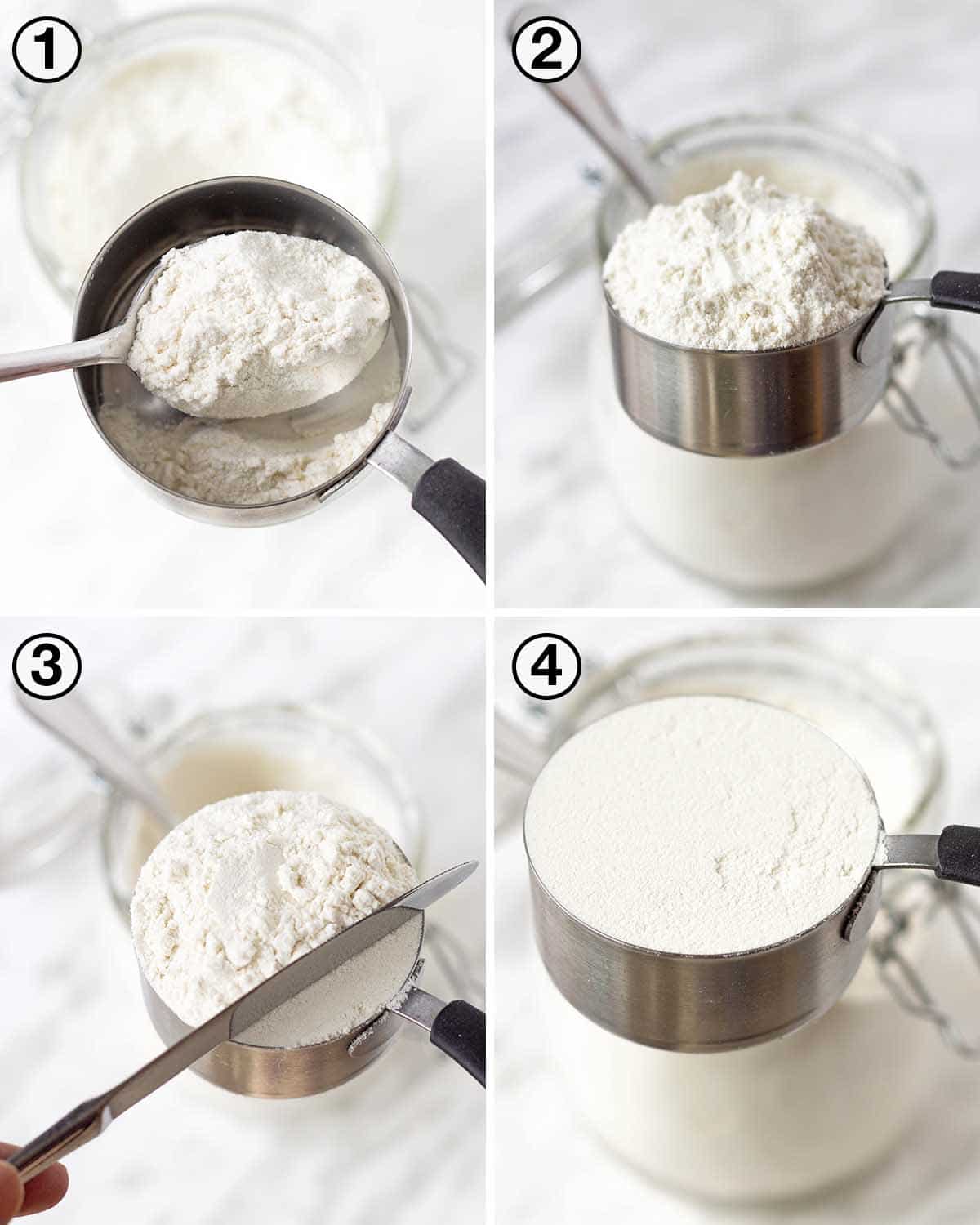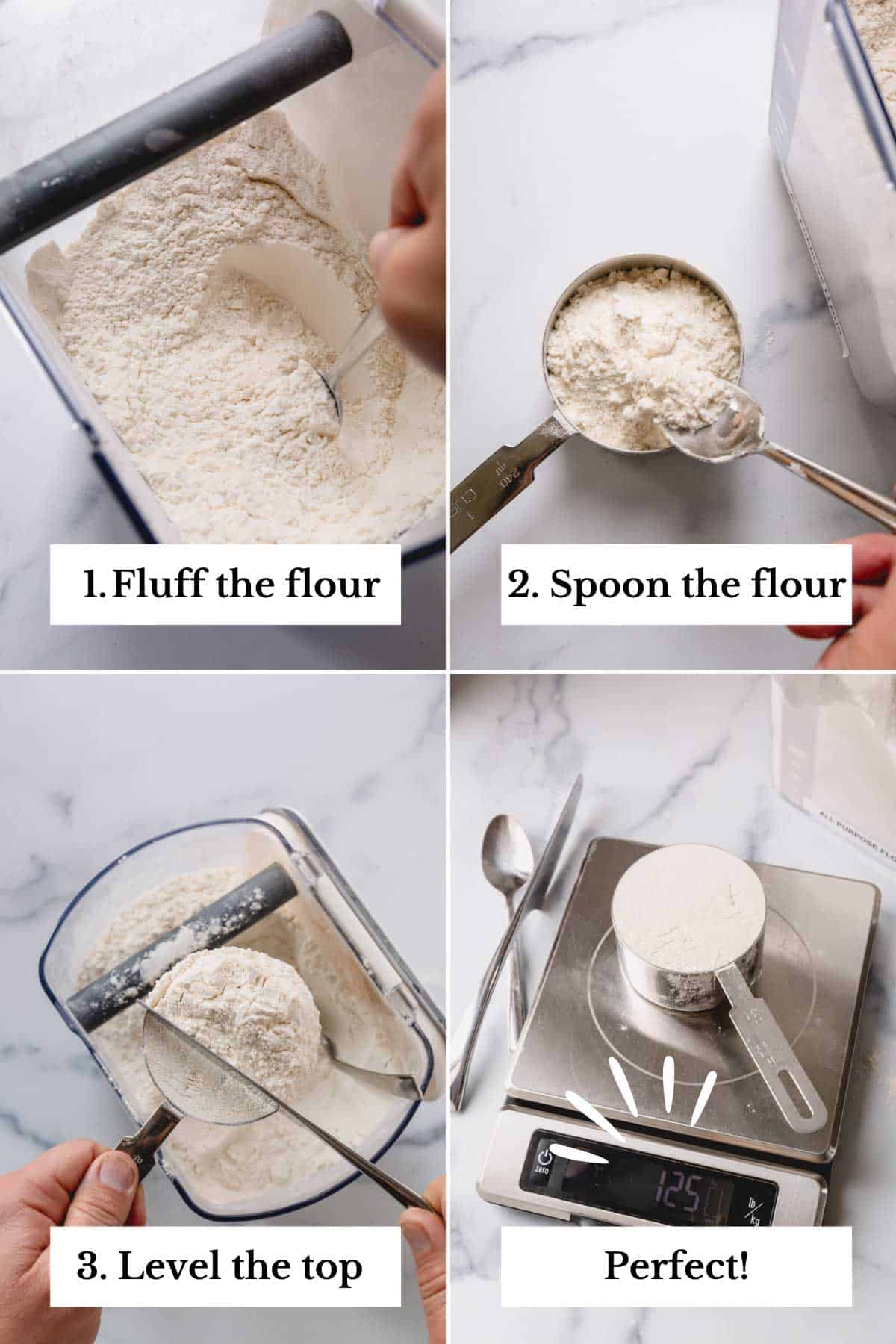Measuring flour correctly is crucial for baking success. Incorrect measurements can ruin your recipe.
Flour is a staple ingredient in many recipes, but getting the measurement right is essential for achieving the desired texture and taste. Whether you’re baking bread, cookies, or cakes, precise flour measurement can make a significant difference. Using too much or too little can lead to dry, dense, or overly moist results.
To help you avoid these common pitfalls, we’ll explore the best methods for measuring flour accurately. Understanding these techniques will ensure your baked goods turn out perfectly every time. Let’s dive into the details and learn how to measure flour correctly for your favorite recipes.

Credit: delightfuladventures.com
Importance Of Accurate Measurement
Measuring flour accurately is a crucial step in baking. Whether you are whipping up a batch of cookies or baking a cake, the right amount of flour can make all the difference. Precise measurement ensures your baked goods turn out perfectly every time.
Baking Consistency
Consistency in baking is key. I remember the frustration of baking bread that turned out dense and heavy because I added too much flour. It was a valuable lesson in the importance of accurate measurement.
Using the right method helps achieve the same results every time. This consistency is essential, especially when baking for special occasions. Your guests will appreciate your efforts when the cake tastes just as good as it did the last time you baked it.
Recipe Success
Accurate flour measurement is vital for recipe success. I once followed a cookie recipe to the letter, but the cookies were dry and crumbly because I didn’t measure the flour correctly.
Flour can be tricky to measure; it’s easy to add too much if you scoop directly from the bag. Instead, spoon the flour into your measuring cup and level it off with a knife. This method ensures you use the correct amount, leading to delicious and perfectly textured cookies.
How do you ensure your flour measurements are precise? Have you ever had a baking disaster due to incorrect measurements?

Credit: www.loveandlemons.com
Tools You Need
To measure flour correctly, use a kitchen scale, measuring cups, or spoons. Level off the flour for accuracy.
When baking, measuring flour correctly is crucial for achieving the desired texture and taste. Using the right tools can make this process straightforward and accurate. Here are the essential tools you need to measure flour correctly.
Measuring Cups
Measuring cups are a staple in every kitchen. Opt for a set of dry measuring cups, typically made of plastic or metal. Ensure you have a variety of sizes, including 1 cup, 1/2 cup, 1/3 cup, and 1/4 cup. When using measuring cups, scoop the flour into the cup and level it off with a flat edge, like a knife. Avoid packing the flour down, as this can lead to using more flour than needed.
Digital Scale
A digital scale offers precision that measuring cups cannot always provide. It’s particularly useful when a recipe specifies the flour amount in grams or ounces. Place a bowl on the scale and zero it out before adding flour. This ensures you only measure the flour’s weight, not the bowl’s. Digital scales can also help you measure small quantities accurately. If a recipe calls for 150 grams of flour, the scale will display the exact amount, eliminating guesswork. Using these tools can make a significant difference in your baking results. What tools do you rely on when measuring flour? Share your experiences in the comments below!
Preparing The Flour
To measure flour correctly, preparing the flour is crucial. This step helps to avoid dense or dry baked goods. You need to ensure the flour is light and airy. Let’s look at how to do this.
Sifting
Sifting flour breaks up any lumps. It also makes the flour lighter. Use a fine-mesh sieve or a sifter for this process. Hold it over a large bowl. Pour the flour into the sieve. Shake it gently. The flour will fall through, leaving any lumps behind. Your flour is now ready for accurate measuring.
Fluffing
Fluffing the flour is another method. It helps to aerate the flour. Use a spoon or fork. Stir the flour in its container. This loosens the packed particles. Fluffing ensures the flour is not dense. This step is simple but important. Now your flour is ready for the next step.
Using Measuring Cups
Using measuring cups is one of the most common ways to measure flour, but it’s also where most people make mistakes. The right technique can make a big difference in your baking results. Here’s how you can do it correctly.
Scooping Method
When you use a measuring cup, it’s important to avoid packing the flour down. Instead, you should lightly scoop the flour into the cup.
Think of it like this: imagine you are filling your cup with feathers. If you press down, you’ll get too much. The same happens with flour.
Gently scoop the flour into the measuring cup until it’s overflowing. Don’t shake the cup or press the flour down. This ensures you get the right amount every time.
Leveling Off
After scooping, you’ll need to level off the excess flour. This step is crucial for accuracy.
Take a straight edge, like the back of a knife or a spatula, and scrape it across the top of the measuring cup. This will remove the extra flour without packing it down.
Ever wondered why your cookies sometimes turn out too dense? It could be because you didn’t level off your flour correctly. This small step can make a big difference.
Remember, baking is a science. Precise measurements lead to better results. What methods do you use to ensure your measurements are accurate?
Using A Digital Scale
Measure flour accurately by placing a bowl on a digital scale and zeroing it out. Add flour until you reach the desired weight. This ensures consistent results in your recipes.
Using a digital scale to measure flour can make a world of difference in your baking. Precision is key, and a digital scale ensures you get the exact amount needed. No more guessing or inconsistent results.
Taring The Scale
First, place your mixing bowl on the scale. Press the tare button to reset the scale to zero. This ensures you only measure the flour, not the bowl. Double-check that the scale reads zero before adding any flour.
Measuring By Weight
Slowly add flour to the bowl until you reach the desired weight. Watch the numbers on the scale closely. A little extra can make a big difference. If you add too much, simply scoop some out and recheck the weight. Using a digital scale might seem like an extra step, but it saves time and guarantees accuracy. Think of it as a small investment for perfect bakes. Have you ever tried using a digital scale for measuring flour? How did it change your baking results?

Credit: www.sweetandsavorybyshinee.com
Common Mistakes
Measuring flour might seem simple. Yet, many people make common mistakes. These errors can ruin a recipe. Understanding these mistakes helps ensure perfect baking results.
Packing Flour
One common mistake is packing flour. Scooping flour directly from the bag packs it down. This leads to more flour than needed. Always use a spoon to fill your measuring cup. Then, level it off with a knife. This ensures accuracy.
Incorrect Tools
Another mistake is using the wrong tools. Measuring flour with a liquid measuring cup is inaccurate. Use dry measuring cups for flour. They provide the right amount without compressing the flour. Remember, accuracy matters in baking.
Tips For Accuracy
Accurate flour measurement ensures perfect baking results. Use a spoon to fill the measuring cup, then level it off with a knife. Avoid packing the flour to prevent over-measuring.
Measuring flour accurately is crucial for baking success. A slight variation can change the texture and taste of your baked goods. Here are some practical tips to ensure precision each time you bake. ###
Using The Right Flour
Different recipes call for different types of flour. Always use the type specified in your recipe. For instance, bread flour has higher protein content, which affects the dough’s elasticity. Using all-purpose flour instead can lead to a denser bread. If you bake frequently, consider keeping a variety of flours on hand. This way, you’ll always have the right one available for any recipe. ###
Checking Expiry Dates
Old flour can ruin your baked goods. Always check the expiry date before using it. Expired flour may not rise properly or could have a stale taste. If you’re unsure, give it a sniff—fresh flour has a neutral smell, while expired flour can have a musty odor. Keeping your flour in an airtight container can extend its shelf life. Store it in a cool, dry place to maintain freshness. By following these tips, you ensure every cup of flour contributes to your baking success. Do you have any flour measurement tips or experiences? Share them in the comments!
Adjusting For Different Flours
Accurately measuring flour is crucial for baking success. Different flours have unique properties. Understanding how to measure them can make a big difference in your recipes. Let’s explore how to adjust for different types of flour.
All-purpose Flour
All-purpose flour is the most common type used in baking. To measure it correctly, first, fluff the flour with a spoon. This helps to aerate and remove any lumps. Next, spoon the flour into your measuring cup. Do not pack it down. Level off the excess with a straight edge. This method ensures you get the right amount.
Whole Wheat Flour
Whole wheat flour is denser than all-purpose flour. It has more bran and germ. To measure whole wheat flour, use the same technique as for all-purpose flour. Fluff it first, then spoon it into your measuring cup. Level off the top. Because it’s denser, you may need to use less of it. Your recipe might need adjustments. Start by using 3/4 of the amount of all-purpose flour suggested. See how it affects the texture.
Frequently Asked Questions
What Is The Proper Way To Measure Flour Accurately?
To measure flour accurately, use a spoon to fluff it in the container. Spoon the flour into a measuring cup, then level it off with a flat edge. Avoid packing the flour.
How Do You Measure The Amount Of Flour?
Use a dry measuring cup, scoop the flour, and level it off with a straight edge. Avoid packing it down.
How Much Is 1 Cup Of Flour?
1 cup of flour is equivalent to approximately 120 grams or 4. 25 ounces. Adjust based on the recipe requirements.
What Should You Not Do When Measuring Flour?
Do not pack flour tightly. Avoid shaking the measuring cup. Do not scoop flour directly from the bag. Avoid using wet measuring cups. Do not level flour with your finger.
Conclusion
Accurately measuring flour is key to successful baking. Use a scale for precision. Fluff the flour before measuring with cups. Spoon it lightly into the cup. Level off with a knife. Avoid compacting the flour. Practice makes perfect. Correct measurements lead to better results.
Follow these steps for consistent baking success. Happy baking!

